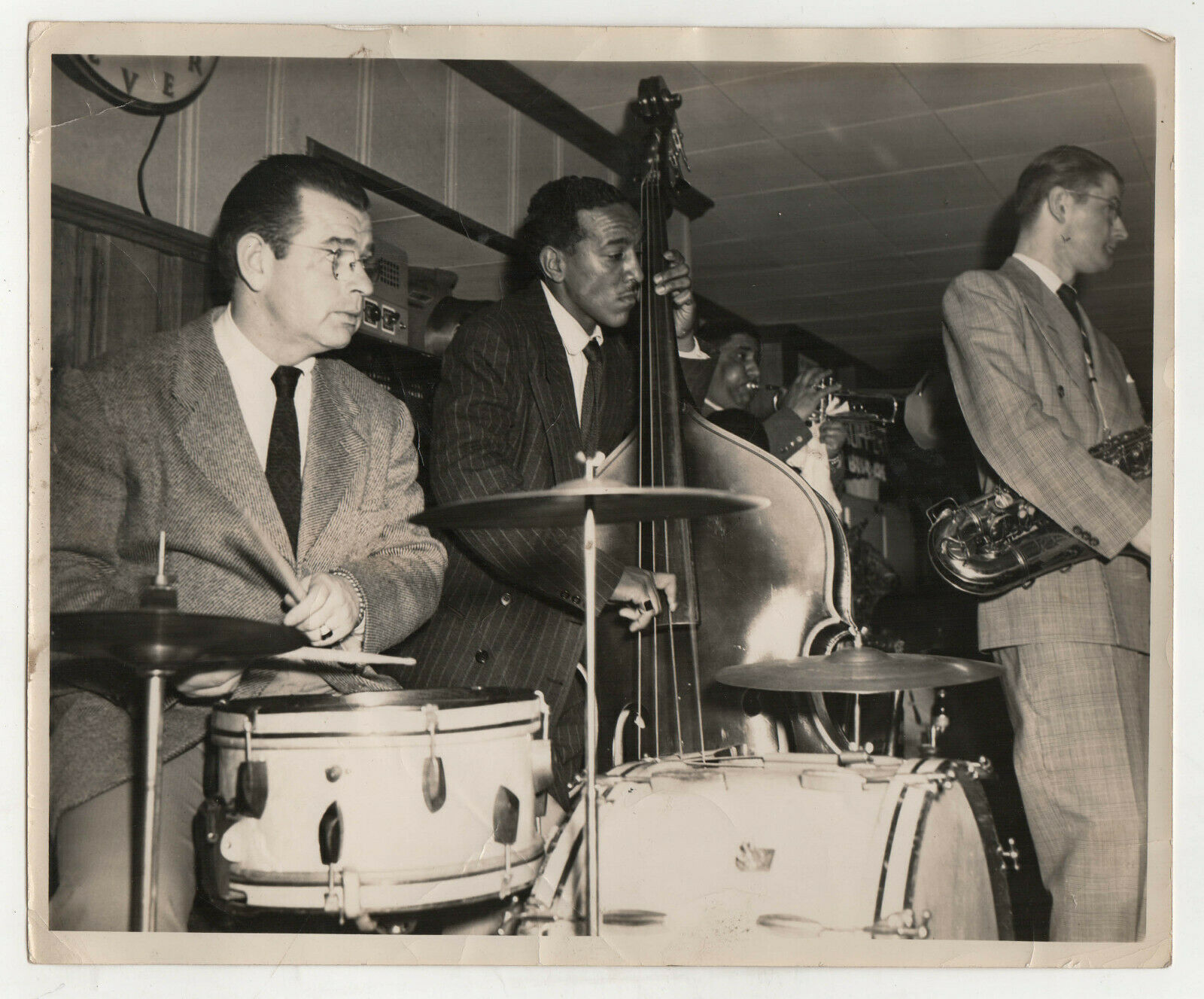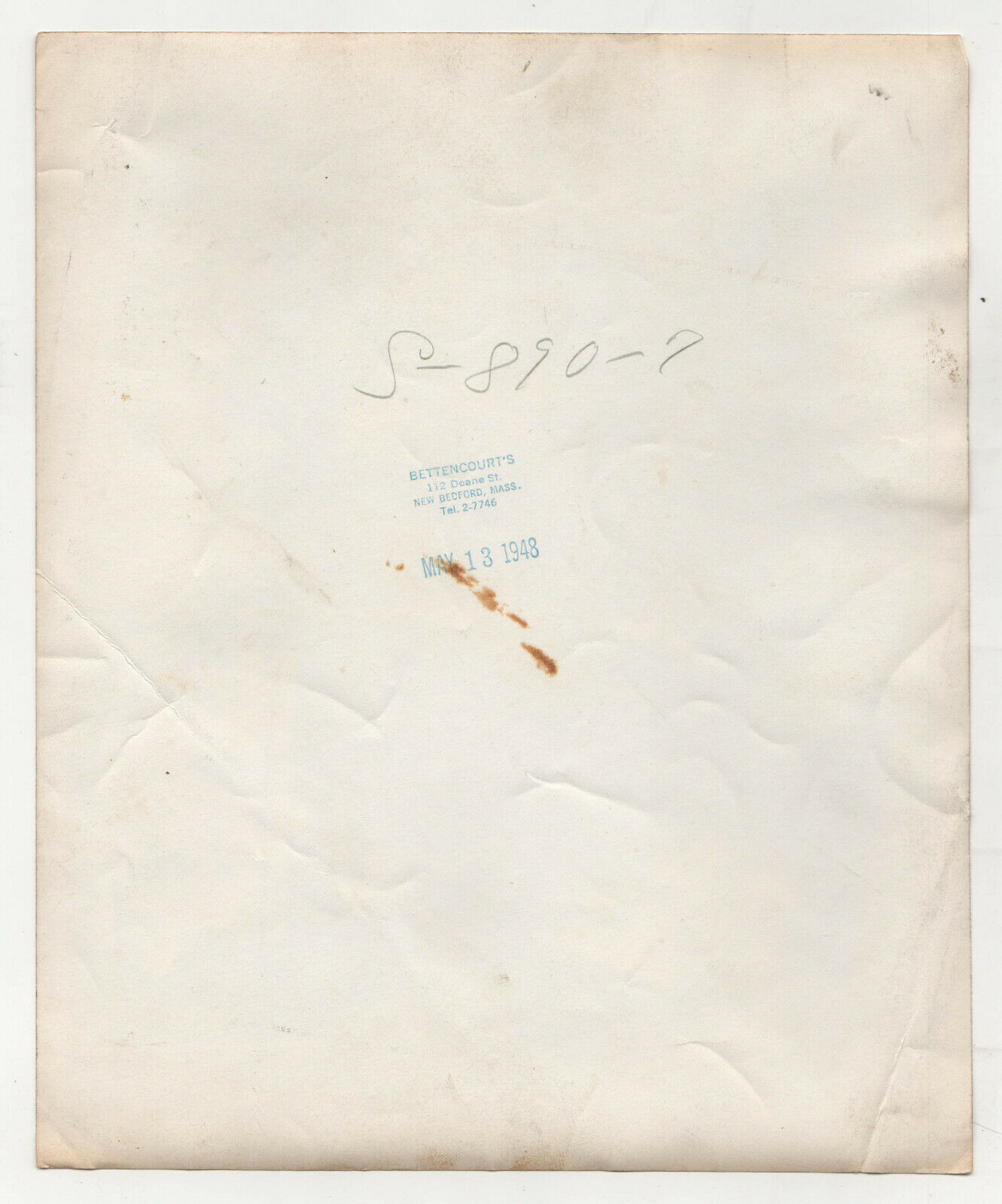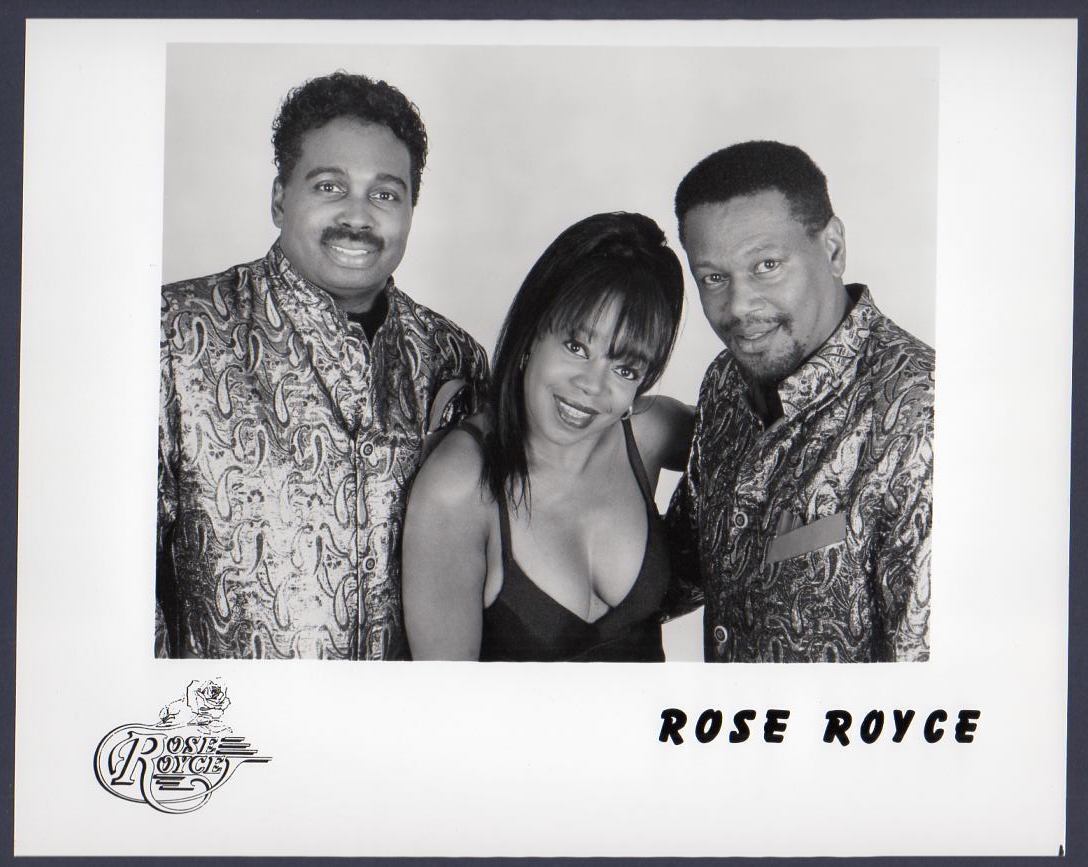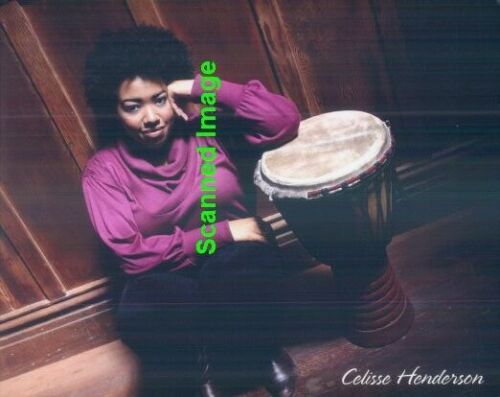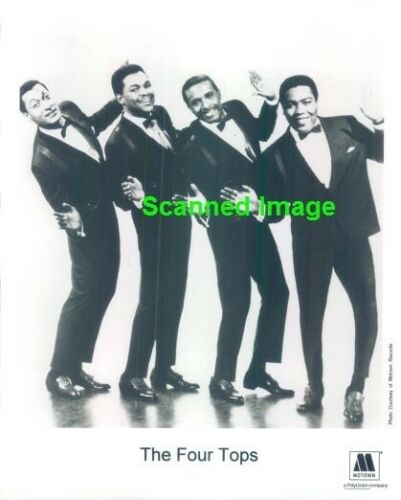-40%
Rare CAPE VERDE Verdean BAND Photograph PHOTO New Bedford R&B Black AFRICAN AMER
$ 13.19
- Description
- Size Guide
Description
CAPE VERDEAN BAND PHOTOGRAPHFREE SHIPPING with delivery confirmation on all domestic purchases!
Rare original 8" x 9-3/4" photograph from New Bedford, Massachusetts dated 1948 showing a band including Cape Verdean musicians. The players are associated with Duke Oliver (Isadore Oliveira) and Phil Edmunds.
We ship worldwide! Please see all pictures and visit
our eBay store and other eBay auctions!
New Bedford is a city in Bristol County, Massachusetts, United States. As of the 2010 census, the city had a total population of 95,072 making it the sixth-largest city in Massachusetts. New Bedford is nicknamed "The Whaling City" because during the 19th century, the city was one of the most important whaling ports in the world, along with Nantucket, Massachusetts and New London, Connecticut.[3] The city, along with Fall River and Taunton, make up the three largest cities in the South Coast region of Massachusetts, and is known for its fishing fleet and accompanying seafood producing industries, as well as having a high concentration of Portuguese Americans.
Before the 17th century, the Wampanoag, who had settlements throughout southeastern Massachusetts and Rhode Island, including Martha's Vineyard and Nantucket, were the only inhabitants of the lands along the Acushnet River. Their population is believed to have been about 12,000. While exploring New England, Bartholomew Gosnold landed on Cuttyhunk Island on May 15, 1602. From there, he explored Cape Cod and the neighboring areas, including the site of present-day New Bedford. However, rather than settle the area, he returned to England at the request of his crew.
Europeans first settled New Bedford in 1652. English Plymouth Colony settlers purchased the land from chief Massasoit of the Wampanoag tribe. Whether the transfer of the land was legitimately done has been the subject of intense controversy. Like other native tribes, the Wampanoags did not share the settlers' concepts of private property. The tribe may have believed they were granting usage rights to the land, not giving it up permanently.
The settlers used the land to build the colonial town of Old Dartmouth (which encompassed not only present-day Dartmouth, but also present-day New Bedford, Acushnet, Fairhaven, and Westport). A section of Old Dartmouth near the west bank of the Acushnet River, originally called Bedford Village, was officially incorporated as the town of New Bedford on February 23, 1787 after the American Revolutionary War. The name was suggested by the Russell family, who were prominent citizens of the community. The Dukes of Bedford, a leading English aristocratic house, also bore the surname Russell. (Bedford, Massachusetts had been incorporated in 1729; hence "New" Bedford.)
The late 18th century was a time of growth for the town. New Bedford's first newspaper, The Medley (also known as New Bedford Marine Journal), was founded in 1792.[4] On June 12, 1792, the town set up its first post office. William Tobey was its first postmaster. The construction of a bridge (originally a toll bridge) between New Bedford and present-day Fairhaven in 1796 also spurred growth. (Fairhaven separated from New Bedford in 1812, forming an independent town that included both present-day Fairhaven and present-day Acushnet.)
On March 18, 1847 the town of New Bedford officially became a city; Abraham Hathaway Howland was elected its first mayor. At approximately the same time, New Bedford began to supplant Nantucket as the nation's preeminent whaling port, thanks to its deeper harbor and location on the mainland. Whaling dominated the economy of the city for much of the century. Many families of the city were involved with it as crew and officers of ships.
Immigration
Until 1800, New Bedford and its surrounding communities were, by and large, populated by Protestants of English, Scottish, Welsh, and Dutch origin. During the first half of the 19th century many Irish people came to Massachusetts. In 1818, Irish immigrants established the Catholic mission that built St. Mary's Church. Later in that century, immigrants from Portugal and its dependent territories of the Azores, Cape Verde, and Madeira began arriving in New Bedford and the surrounding area, attracted by jobs in the whaling industry; many had family members who had worked on whaling ships. As the Portuguese community began to increase, they established the first Portuguese parish in the city, St. John the Baptist (1871). French Canadians also secured a foothold in New Bedford at about the same time, and they built the Church of the Sacred Heart in 1877.
Similarly, Polish immigrants began arriving in the late 19th century and established the parish of Our Lady of Perpetual Help in 1903. A number of Jewish families, arriving in the late 19th century, were active in the whaling industry, selling provisions and outfitting ships. During the years leading up to the First World War, a sizable eastern-European Jewish community joined them in New Bedford. Some became prominent merchants and businessmen, mainly in textiles and manufacturing.
Establishments
In 1847, the New Bedford Horticultural Society was begun by James Arnold.[5]
The Ash Street Jail, which houses inmates from Bristol County, is located in New Bedford. It opened in 1829 and is the oldest continuously operating jail in the United States.[6]
Fort Taber and Fort Rodman (also called the "Fort at Clark's Point") were built during the American Civil War and are now in Fort Taber Park. Both forts are often called Fort Taber, including in some references.[7]
Geography
New Bedford is located at 41°39′06″N 70°56′01″W (41.651803, −70.933705).[8] According to the United States Census Bureau, the city has a total area of 24.1 square miles (62.5 km2). Of the total area, 20.0 square miles (51.8 km2) is land, and 4.1 square miles (10.7 km2), or 17.13%, is water.[9] New Bedford is a coastal city, a seaport, bordered on the west by Dartmouth, on the north by Freetown, on the east by Acushnet and Fairhaven, and on the south by Buzzards Bay. From New Bedford's northern border with Freetown to the Buzzards Bay coast at Clark's Point the distance is approximately 14 miles (23 km). Across New Bedford east to west is a distance of about 2 miles (3.2 km). The highest point in the city is an unnamed hill crossed by Interstate 195 and Hathaway Road west of downtown, with an elevation greater than 180 feet (55 m) above sea level.[10]
New Bedford Harbor, a body of water shared with Fairhaven, is actually the estuary of the Acushnet River where it empties into Buzzards Bay. The river empties into the bay beyond Clark's Point, the southernmost point of the city. To the west of Clark's Point is Clark's Cove, which extends landward approximately one and a half mile from the bay. Just south of Palmer's Island, beginning near Fort Phoenix in Fairhaven, lies a two-mile-long hurricane barrier, constructed in the 1960s to protect the inner harbor where the fishing fleet anchors. Along with Palmer's Island, the city also lays claim to Fish Island and Pope's Island. Between these two islands lies one of the three sections, the central section, of the New Bedford-Fairhaven Bridge. The central span, a swing bridge, connects the two islands as well as allowing boats and ships passage to the upper harbor. Two conventional bridges connect each of the islands to the nearest mainland, Fish Island to New Bedford and Pope's Island to Fairhaven. In addition to the harbor, there are several small brooks and ponds within the city limits.
Cape Verdean Americans are Americans whose ancestors were Cape Verdean.
In 2010, the American Community Survey stated that there were 95,003 Americans living in the US with Cape Verdean ancestors.
Cape Verdean immigration to the United States began in the early 19th century. The first Cape Verdean immigrants aboard New England whaling ships, which would often pick up crewmen off the coast of Cape Verde. Yankee captains valued Cape Verdeans as crews, because they “worked hard to save what they could while on board vessel they could be hired for much less money than American seamen. Furthermore, they made a disciplined crew.”[3]
The Cape Verdeans were universally regarded as "hardworking, honest seamen." When all others abandoned the old sailing ships, the Cape Verdeans bought the decrepit vessels out of their earnings as seamen and kept patching them up with loving care. Eventually, they came to own almost all that remained of the New Bedford fleet, either by purchase or by default. In some cases, they received the ships as outright gifts and "sailed them all over the earth with their own crews and made a modest profit by whaling in the old and tried manner."
This Cape Verdean immigration "trickle" grew to a "flood" in the 20th century as Cape Verde suffered drought, starvation, and economic decline.[4] Once on whaling ships and in America, Cape Verdean men were able to send home money and news of other family and friends already in “the land of opportunity.” They also sent bidons (gasoline barrels) full of food, clothes, and other items from New Bedford, Massachusetts; and Providence, Rhode Island. The latter are the oldest and largest Cape Verdean communities in the United States. These communities and new Cape Verdean communities are marked by close kinship ties and interdependence among families, a traditional Cape Verdean practice that has been passed down through the generations.
One of the major forces that brought Cape Verdeans to the Americas was the whaling industry. American whalers from New Bedford first began travelling to the islands in the 1790s, and further developed their trade as time progressed into the 19th century. During this time, many Cape Verdeans joined American whaling crews in order to escape Cape Verde, a land plagued with poor natural resources and an often abusive Portuguese colonial government. By the mid-1800s New Bedford had transformed into an economic maritime center, where Cape Verdeans were not only about to excel in the whaling industry but in other maritime industries (such as fishing) as well.[5] New Bedford Whaling Museum explains, “As the 20th century went on and the ties between the islands and the port strengthened, entrepreneurs like Roy Teixeira, Henrique Mendes, Louis Lopes, Frank Lopes and Antonio Cardoza purchased, managed and owned packet ships like the Coriolanus, the Savoia, and the Arcturus... Importantly, not only did Cape Verdeans settle in New Bedford, but between 1860 and 1965 41% of the packets trading between New England and the Islands were owned by Cape Verdeans.”[5]
Many Cape Verdeans worked in the cranberry bogs for the cranberry industry in Southeastern Massachusetts.[6][7]
Cape Verdean migration to the United States in the 19th century and early 20th century was composed of the islands' poorer classes. In 1922, the U.S. government restricted the immigration of peoples of color, greatly reducing Cape Verdean immigration. The new regulations also prevented Cape Verdean Americans from visiting the islands for fear of being denied reentry to the United States. The two communities thus were relatively isolated from each other for approximately 40 years. With doors to America closed, Cape Verdeans began to immigrate in larger numbers to Europe, South America, and West Africa along routes charted by commercial shipping and the Portuguese colonial empire. During the same period some Cape Verdean Americans migrated from the long-established East Coast communities to the steel towns of Ohio and Pennsylvania; and to California.
In 1966, due to the Immigration and Nationality Act of 1965, the U.S. government relaxed its regulations, and a new wave of Cape Verdean immigration began. The new arrivals in Boston, Brockton, Taunton and Onset, Massachusetts; Pawtucket, Rhode Island; Waterbury, Connecticut; Brooklyn, and Yonkers, New York; and other communities on the East Coast met a Cape Verdean-American ethnic group whose members looked like them, but differed culturally. Separated for so long, the groups knew little of each other's recent history or treasured memories.[8]
Full independence was achieved by Cape Verde on July 5, 1975 after a long struggle for complete rights and unrestricted control from the struggle of the country’s colonial past. Though growing nationalism, prior efforts for independence slowly gained momentum and territory led by the efforts of the African Party for the Independence of Guinea and Cape Verde (PAIGC). This newfound independence allowed a new path that would be essential to the migration of Cape Verdean American as Cape Verde was one of few African countries allowing overflight of European and U.S. air travel. This was accompanied by two further actions of independence that aided Cape Verdean migration: broken political unity between Guinea in 1980, and the election of Antonio Monteiro which brought economic struggles that incited emigration.[9]
_______________________________________________________________
Why Buy From Chestnut Hill Books?
Chestnut Hill Books has a perfect 100% feedback rating dating over 18 years and spanning 20,000+ transactions, with customers in all 50 states and over 100 countries on 6 continents. Our detailed seller ratings (item as described, communication, shipping time and shipping and handling charges) are among the best on eBay. All domestic purchases come with free shipping and complimentary delivery confirmation, trackable through
the United States Post Office.
Thank you for looking at our items!
Payment:
Payment is due within 7 days of purchase. Contact us
for special payment requests/options. If payment cannot be produced within the 7 day period, please send a message immediately indicating when payment should be expected, otherwise an unpaid item dispute will be filed with eBay.
Where Do We Ship?
Chestnut Hill Books ships to every country in the world at reasonable rates as suggested by the United States Postal Service.
Please contact us for a specific international shipping quote before bidding should you have any questions.
Shipping Terms:
If payment is made immediately, your item will usually be mailed within 24 hours of payment receipt.
All items are securely packed to ensure safe shipping. Postcards are mailed between sturdy cardboard. All domestic shipments come with complimentary delivery confirmation, trackable through
the USPS
. Buyers will receive an e-mail from PayPal with tracking information and related links; please refer to this e-mail before contacting us with questions on the status of your package, as we will have as much delivery information as you. Zero profit is made on international shipping & handling charges; domestic shipping is free.
Return Policy:
We strive to describe each item completely and accurately. However, if you feel an item was not described correctly, the item can be returned at our expense within 30 days of receipt for a refund of your original payment. It is requested that you contact us immediately
should you have any question about the condition or representation of your item.
Who Are We?
Chestnut Hill Books is a family-owned antiques business based out of the SouthCoast, Massachusetts. We collect historical items related to New Bedford, Massachusetts and the surrounding area (Dartmouth, Fairhaven, Westport etc), Boston College (tickets, programs, pennants, postcards, scrapbooks, pinbacks, sports & non-sports etc), Massachusetts political buttons & memorabilia and Mount Monadnock in Jaffrey, New Hampshire. Please contact us if you have any collectibles in those categories.
Other:
Please do not hesitate to contact us with any other questions/comments. We normally respond to all inquiries in a timely manner. Also, please do not forget to leave positive feedback upon item receipt! Thank you for looking at our listings!
_______________________________________________________________
